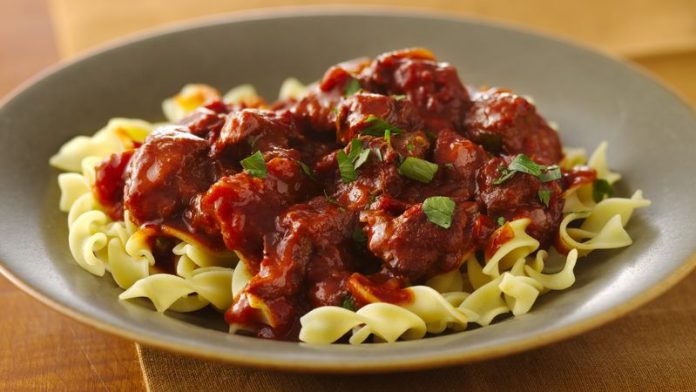Table of Contents
There are several variations and styles of goulash recipes that you may be somewhat familiar with, especially if you grew up in the Midwest like me. I can remember cold snowy evenings coming home from school and smelling that familiar comforting aroma of goulash coming from my mother’s kitchen. I knew my favorite comfort food was slowing cooking and one of my family’s absolute best meals would be served that night for dinner. Today I want to look at some of the ways to cook this delightful dish and offer some opinions on which are best. If you’d like to join in on this goulash adventure read on in our article titled Goulash recipes: American vs. Hungarian.
There are two main styles of goulash, traditional Hungarian, and the classic American. With a few variations on each style, we are going to sort through and determine which might be best for your family’s dinner table. Rest assured that whichever you choose and how you decide to cook this dish, you will not be disappointed, there is not a better comfort out there and I promise if you follow this guide and use one of the recipes below you will be very cozy and warm as you eat this amazing dish.
Let’s take a quick look at what goulash is and what the history of this fantastic dish is. The Goulash recipe is kind of an in between a stew and a soup. Unlike a few stews, it isn’t excessively packed full of veggies and beef, it’s a nit more brothy. But through the cooking procedure, the broth of it becomes thicker and more like rich sauce. The goulash’s origins dates back to the nineteenth century, to the stews eaten by Magyar Shepherds. That stew was dried in the open sun and then packed into the bags made using the stomachs of sheep. At the mealtimes, the water was then added to the portion of the meat for reconstituting it into a stew or a soup. The Goulash word derives from Gulyás which is a Hungarian word. It is pronounced the same just with the L silent, which is a word for the Hungarian Cowboy or Herdsman. As the herdsman go for the castle drives and would butcher the weaker cows that might not make the rive and then make a soup or a stew from them.
Let’s first take a look at the traditional Hungarian dish, here is a very good recipe I’ve used dozens of times and it is truly delightful:
Ingredients
- 2 teaspoons lard or butter (preferred)
- 2 medium-sized onions
- 2 tablespoons paprika
- 1 teaspoon caraway seeds
- 1 and 1/2 pound stewing beef cut into 1″ cubes
- 1/4 cup flour
- 1 cup diced canned tomatoes
- 2 cups beef water or broth
- 1/4 teaspoon pepper
- 1 teaspoon salt
Optional
- 3 cups potatoes optional
- 1 and 1/2 cup carrots optional
Instructions
- In a big pot, melt the butter first and then add your onions. Cook it till translucent. Now, stir in the paprika and caraway seeds and mix it well.
- Now take a bowl and dredge the beef stew with flour in it. Add beef to the mixture of onion and then cook for about two to three minutes.
- Now gradually add ¼ cup of the beef broth for lifting the brown bits off the pan’s bottom. Now add the remaining broth, pepper, salt, diced tomatoes (carrots and potatoes if using).
- Stir it well and bring to a boil, cover it and then reduce it to a simmer for about one and a half to two hours or until its tender.
Now let’s take a look at the classic American goulash:
Ingredients:
- 1-1/2 cups minced onions
- 1 pound Ground Beef (93 percent lean or leaner)
- 15 ounces (1 can) unsalted tomato sauce
- 1 tablespoon minced garlic
- 1-1/2 cups water
- 14-1/2 ounces (1 can) unsalted diced tomatoes
- 1 tablespoon paprika
- 2 tablespoons reduced-sodium soy sauce
- 1 teaspoon seasoned salt
- 2 teaspoons dried Italian seasoning
- 1 cup uncooked elbow macaroni
- 1 bay leaf
Garnish
- Shredded Parmesan cheese
Instructions:
- First of all, heat the large stock pot over the medium flame until its hot. Then add onions, ground beef and garlic and cook for about eight to ten minutes, breaking into half an inch crumbles, stir it occasionally or until the onions are translucent.
- Now, stir in the tomato sauce, water, diced tomatoes, paprika, soy sauce, seasoned salt, Italian seasoning and bay leaf then bring to a boil. Once it starts boiling, reduce the heat and cover tightly then simmer for twenty minutes and keep stirring occasionally.
- Then, stir in your macaroni, cover and then simmer for about twenty minutes or until your pasta is tender, keep stirring occasionally. Now remove the pot from heat and discard the bay leaf. Garnish using the parmesan cheese if you like.
As you can see above there are differences between the two styles, which is best is really up to the individual. But for me personally I am a big fan of the classic American, I just love the macaroni noodles, and goulash is not goulash without them. But whichever you choose you will not be disappointed in this classic comfort food, pick up the ingredients and delight your family tonight!







